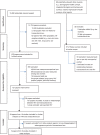Transactional sex and risk for HIV infection in sub-Saharan Africa: a systematic review and meta-analysis
- PMID: 27809960
- PMCID: PMC5095351
- DOI: 10.7448/IAS.19.1.20992
Transactional sex and risk for HIV infection in sub-Saharan Africa: a systematic review and meta-analysis
Abstract
Introduction: Young women aged 15 to 24 years in sub-Saharan Africa continue to be disproportionately affected by HIV. A growing number of studies have suggested that the practice of transactional sex may in part explain women's heightened risk, but evidence on the association between transactional sex and HIV has not yet been synthesized. We set out to systematically review studies that assess the relationship between transactional sex and HIV among men and women in sub-Saharan Africa and to summarize the findings through a meta-analysis.
Methods: The search strategy included 8 databases, hand searches in 10 journals, and searches across 17 websites and portals for organizations as informed by expert colleagues. A systematic review of cross-sectional and longitudinal studies was carried out for studies on women and men who engage in transactional sex published up through 2014. Random effects meta-analysis was used to further examine the relationship between transactional sex and prevalent HIV infection across a subset of studies with the same exposure period. Analyses were conducted separately for men and women.
Results: Nineteen papers from 16 studies met our inclusion criteria. Of these 16 studies, 14 provided data on women and 10 on men. We find a significant, positive, unadjusted or adjusted association between transactional sex and HIV in 10 of 14 studies for women, one of which used a longitudinal design (relative risk (RR)=2.06, 95% confidence interval (CI): 1.22 -3.48). Out of 10 studies involving men, only 2 indicate a positive association between HIV and transactional sex in unadjusted or adjusted models. The meta-analysis confirmed general findings from the systematic review (unadjusted meta-analysis findings are significant for women (n=4; pooled odds ratio (OR)=1.54, 95% CI: 1.04-2.28; I2=42.5%, p=0.156), but not for men (n=4; pooled OR=1.47, 95% CI: 0.85-2.56; I2=50.8%, p=0.107).
Conclusions: Transactional sex is associated with HIV among women, whereas findings for men were inconclusive. Given that only two studies used a longitudinal approach, there remains a need for better measurement of the practice of transactional sex and additional longitudinal studies to establish the causal pathways between transactional sex and HIV.
Keywords: HIV; adolescent; sexual behaviour; sub-Saharan Africa; transactional sex; young women.
Conflict of interest statement
The authors have no competing interest to declare.
Figures
References
-
- Anderson SJ, Cherutich P, Kilonzo N, Cremin I, Fecht D, Kimanga D, et al. Maximising the effect of combination HIV prevention through prioritisation of the people and places in greatest need: a modelling study. Lancet. 2014;384(9939):249–56. doi: http://dx.doi.org/10.1016/S0140-6736(14)61053-9. - DOI - PubMed
-
- UNAIDS. Geneva: UNAIDS; 2013. Global report: UNAIDS report on the global AIDS epidemic 2013.
-
- United Nations Children's Fund. New York: UNICEF; 2012. Progress for children: a report card on adolescents United Nations Plazza. - PubMed
-
- Beauclair R, Delva W. Is younger really safer? A qualitative study of perceived risks and benefits of age-disparate relationships among women in Cape Town, South Africa. PLoS One. 2013;8(11):e81748. doi: http://dx.doi.org/10.1371/journal.pone.0081748. - DOI - PMC - PubMed
-
- Gregson S, Nyamukapa C, Garnett G, Mason P, Zhuwau P, Carael M. Sexual mixing patterns and sex-differentials in teenage exposure to HIV infection in rural Zimbabwe. Lancet. 2002;359:1986–03. doi: http://dx.doi.org/10.1016/S0140-6736(02)08780-9. - DOI - PubMed
Publication types
MeSH terms
LinkOut - more resources
Full Text Sources
Other Literature Sources
Medical
Miscellaneous




